| Clutching My Pearls is my ongoing blog series about my take on Jane Austen’s beliefs and ideas, as based on her novels. I’ve also been blogging about now-obscure authors of the long 18th century. For more, click "Authoresses" on the menu at right. Click here for the first in the series. |
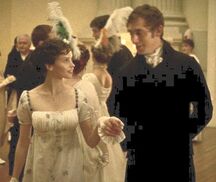 The whirl of Bath with Catherine Morland (Felicity Jones) and Henry Tilney (JJ Feild)
The whirl of Bath with Catherine Morland (Felicity Jones) and Henry Tilney (JJ Feild) - Adriana, the heroine, is troubled by the unwanted attentions of young Mr. Dawson, who is very much a John Thorpe (Northanger Abbey) type of character.
- The publisher, Benjamin Crosby, threatened to sue another publisher who brought out a book called A Winter at Bath at the same time, a dispute which spilled over to the newspapers and the review columns.
- A Winter in Bath is tied to the mystery over the authorship of The Woman of Colour, the unusual 1803 novel which features a “mulatto” heiress as its main character. More about that later.
- There is an Emma-like reference which might be interesting to Janeites. Mrs. Elton, the daughter of a Bristol trader in Emma, boasts that she has “resources within herself” which enable her to live in obscurity in the small village of Highbury. In A Winter in Bath, we have a minor character, Mr. Oakley. He was a prosperous Bristol trader who retires and moves to live like a gentleman in the country. But he misses his old life because he’s not interested in hunting or field sports and intellectually, he is: “[d]estitute of resources, with no taste for any intellectual or refined amusement….”
- This novel features a lesbian couple as minor characters. Have we got your attention now, modern academy?
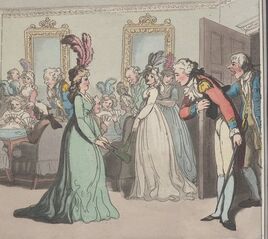 Thomas Rowlandson, "Comforts of Bath" series
Thomas Rowlandson, "Comforts of Bath" series A Winter in Bath received two sharply different reviews—one trashing it, and one praising it. I think the critical review was biassed and unfair. This novel is not “insipid” and “uninteresting.” It should not be “consigned to the flames.” Fine, you can take issue with the practise of putting thinly-disguised famous people into novels, (that is, people who were famous back then, I have no idea who the author is lampooning in A Winter in Bath), but the story itself is well-structured and has an appealing heroine, as sentimental heroines go.
The author arouses our sympathies from the beginning because Adriana Hartley has been neglected by her fashionable parents, who leave her for years in a remote boarding school and then summon her to London when she turns seventeen. When she arrives, eager to be reunited, she discovers they couldn’t be bothered to stay at home for her, but have both gone out for the night to separate amusements. When she wakes up early the next morning (as heroines in London always do, to the surprise of the servants), mom and dad sleep in for hours, and only give her a quick greeting before they start dressing to go out again.
Dad wants to get Adriana on the marriage market quickly, but mom is embarrassed to have it known that she, a society beauty, has a grown-up daughter, so she refers to Adriana as a "child."
| Mr. Falkland is smitten when he sees Adriana teaching a poor little girl her catechism--a primer on religious faith that children were required to memorize. Novels often showed heroines performing acts of charity. | Adriana was educated by a virtuous and wise teacher, so she can’t help but see that her mom and dad lead separate but dissolute lives. But she’s too young and innocent to understand what's going on when catastrophe breaks upon them—mom runs off with another man. Her father, without explanation, swiftly packs her off to her maternal grandmother’s house in the country. The news of her daughter’s adulterous elopement reaches Mrs. Cosby before her granddaughter does, the shock kills her, and Adriana gets there only in time to say good-bye. There she is, seventeen years old, living in the country with only the servants to keep her company, and one of them is a hellfire-and-brimstone Methodist. (Methodists were often satirized and critiqued in these old novels). Luckily, Mr. and Mrs. Selwyn, the local clergyman and his wife, are very kind. Through them, Adriana meets a saucy, madcap, heiress, Cecelia Oakley. It is only when she attends a ball hosted by Cecelia that Adriana overhears people gossiping about her mother—only then does she understand what has happened—only then she learns why her father has gone to France—he is tracking down his wife's seducer to challenge him to a duel, as the social rules decree. Now Adriana realizes that her mother’s scandal may affect her own reputation. |
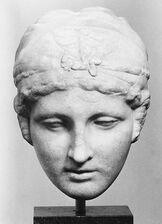 Bust of Sappho, hint, hint. (Metropolitan Museum)
Bust of Sappho, hint, hint. (Metropolitan Museum) As I mentioned, I think the story is not bad, as compared to other novels of this era. The author keeps the plot and sub-plots in motion. For example, the madcap heiress Cecelia is pursued by Lord Maybury, an impoverished fortune-hunter—I need hardly mention that he is Irish, of course—then he propositions Adriana, (that is, to be his mistress, not to marry him). She is disgusted at his behaviour, but events conspire to keep her from warning her friend before Cecelia marries him. Finally we get to Bath, to have our “Winter in Bath.”
Bath is a logical locale for a “season” novel about fashionable life. As scholar Amy Prendergast notes: “Bath became recognised, alongside London, as one of the most popular international marriage markets.... Bath came to provide the setting for the unfolding of various marriage plots and their contingent narrative complications, with the mixing of people from different locales... with Frances Sheridan’s play A Journey to Bath (c. 1765) and her son Richard Brinsley’s The Rivals (1775) representing key examples, alongside novels by Jane Austen, Frances Burney, and Amelia Opie.”
We get into interminable scenes of high life which have little interest for me because I don’t know who is being lampooned. Are Mrs. D’Onolly and her bosom friend Miss Filmer based on real people? Mrs. D’Onolly, says Prendergast, “embodies the caricature of the older widow travelling to Bath to ‘gain a second husband,’” but she is also a vehicle for introducing another aspect of “season” novels—the characters in them tend to discuss literature and current events. Mrs. D’Onolly fancies herself a poet and patron of the arts, and follows the “path of sentiment, philosophy, and all the theory of refinement and contradiction with which some of the modern writers have lately contrived to bewilder the brains of their fair readers.”
There are also many broad hints about Mrs. D’Onolly and Miss Filmer. “Miss Filmer constantly and unceasingly averred, that Mrs D’Onolly’s head was quite a model for the bust of Sappho; and that the glowing thoughts of the Grecian poetess were like the fine frenzied imagination of her adored D’Onolly!” Get your “interrogating” boots on, academic ladies! You’re needed to explain how this satirical portrayal of a lesbian couple in a highly didactic, overtly religious novel, is actually a sympathetic one which subverts gender norms.
 The Ruined Gamester, Thomas Rowlandson, (detail)
The Ruined Gamester, Thomas Rowlandson, (detail) Adriana, being a heroine, doesn’t care for the late nights, the vortex of dissipation, the false glare and tinsel of the city. She doesn’t like the crowd the Mayburys run with: “gamblers of both sexes, half-pay officers, withered beauties, petits maitres, Irish widows, younger brothers, and every amateur singer, dancer, spouter, declaimer, pedestrian, equestrian, and boxer…” attend Lady Maybury’s entertainments and “all that was decent and respectable seemed to side off from an introduction, as if by general consent.”
Adriana’s father returns on the scene, and she realizes that he’s a compulsive gambler who has destroyed the family fortunes, and he only looks at her as a meal ticket. He plans to sell her off in marriage and he expects her to obey. The author bluntly refers to this as “legal prostitution.” Her father’s choice is a Mr. Dawson, who is another John Thorpe; a stupid, clumsy oaf. There is also a passable suitor, Sir Lionel Herbert, but he abruptly disappears just before she has reason to believe he will propose. How Adriana misses her friend Mr. Falkland!
Adriana's father is compelled to put the dead grandmother’s country home up for sale. Then he disappears, leaving Adriana with nothing. Instead of being the heiress of a respectable family, she is now the penniless daughter of scandal. She faces up to this with considerable strength of character; she understands that she’ll have to look for a job. In the meantime, she moves in with Lord and Lady Maybury because she has nowhere else to go, but this is more than awkward because Lady Maybury resents Lord Maybury’s attentions to her. After he attempts outright assault on her, Adriana realizes she must get out of Bath. She resolves to sell a valuable lace veil to get money to return to the country and ask for the protection of the clergyman and his wife. This sets off a chain of events, or should I say a chain of coincidences, in which Adriana is reunited with her mother who is (a) very repentant about everything she’s done and (b) on her death-bed. Then Adriana is rescued from Bath by Mr. Falkland, who has come looking for her.
You may have guessed that Mr. Falkland is a Mr. Knightley/Colonel Brandon type—the older mentor turned lover. He is also as generous as Mr. Darcy, because it turns out he’s the purchaser of the beloved old country home. Dad, meanwhile, dies in a duel with his late wife’s lover.
The other review, much shorter, says: “The story is well written, the incidents are good, and the characters are excellently pourtrayed.” And oops!--I have learned in an article by scholar Anthony Mandal that the periodical which published the good review, Flowers of Literature, was owned by Crosby, so he is praising his own publication!
For now, except for the soggy middle of this novel with its overextended scenes of Bath life—the giddy maze of folly and the vortex of pleasure--I would say this is a decent read with a likeable heroine. For what it’s worth, I had no objection to Mr. Falkland. He treats Adriana with respect, not condescension, and I’m sure they lived happily ever after.
Every novel has to have a moral, as the Critical Review article says: "It is the province of the novelist to mould into an agreeable fiction such events and circumstances as may illustrate the prevailing weaknesses and the peculiar virtues of human nature, and uniformly to excite the sympathy of the reader in favour of moral excellence."
In her opening, the author expresses pity for the innocent daughters whose reputations are damaged by the actions of their mothers, but she defends the unkind necessity of ostracizing the “frail sister” from society. “Such are the laws of the world—and such should they be; for these [social sanctions] operate on minds which are unaffected by religion, and contribute to keep the decencies of life from being violated…” A Winter in Bath, therefore continues my string of novels in which virtue and reputation are the paramount themes.
Previous post: Emily, the likeable heroine Next Post: Forgotten bestseller Charlotte Temple
| Janeites know that Crosby and Co. was the publisher who bought the first version of Northanger Abbey, then titled Susan, for ten pounds, but never published it. Years later, Austen bought it back, revised it, and it was published after her death by John Murray. Prendergast, Amy. “A Winter in Bath, 1796-97: Life Writing and the Irish Adolescent Self.” The European Journal of Life Writing, vol. 10, 2021, pp. 18–40 A. A. Mandal, "Making Austen Mad: Benjamin Crosby and the Non-Publication of Susan," The Review of English Studies, Volume 57, Issue 231, September 2006, Pages 507–525, Stevens. (2017). "The Season Novel, 1806-1824: A Nineteenth-Century Microgenre". Victoriographies, 7(2), 81–100. |

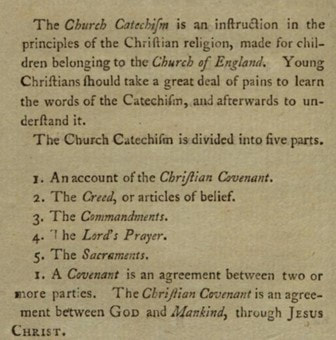
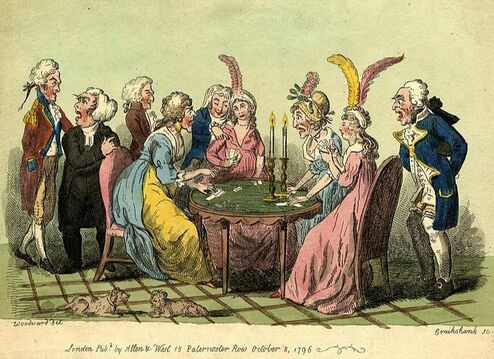
 RSS Feed
RSS Feed